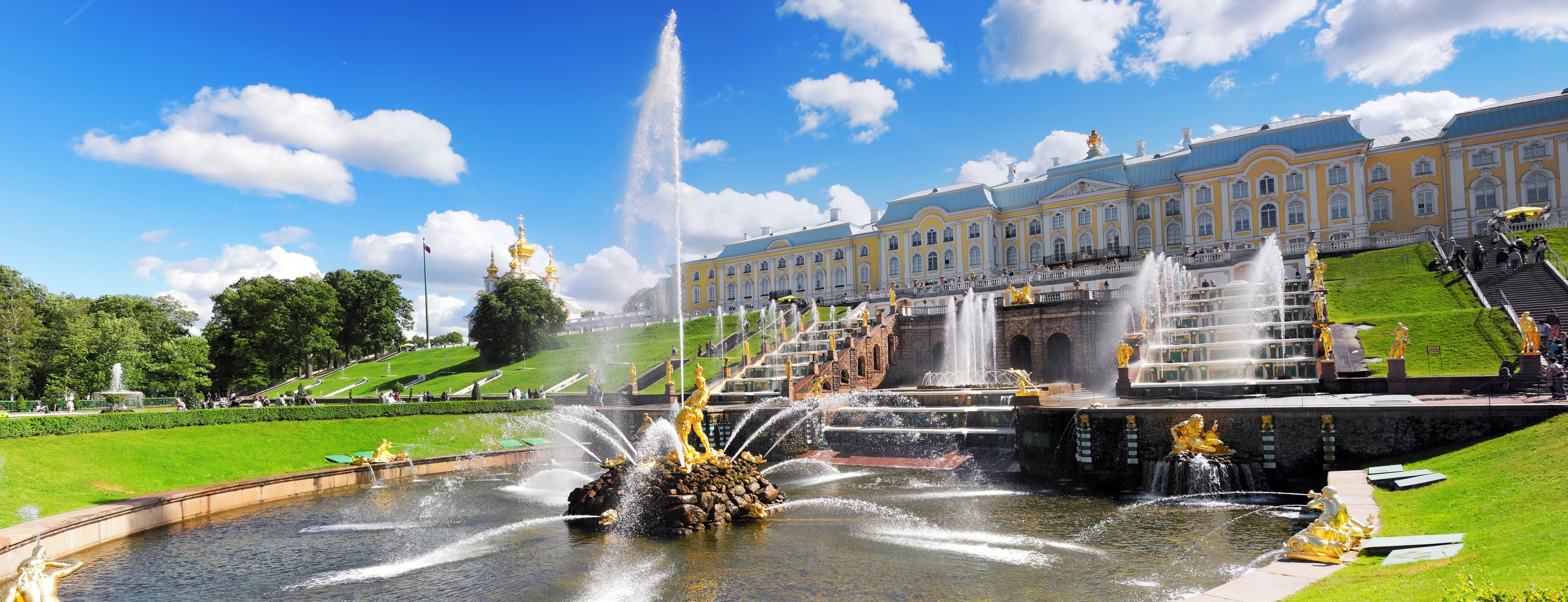
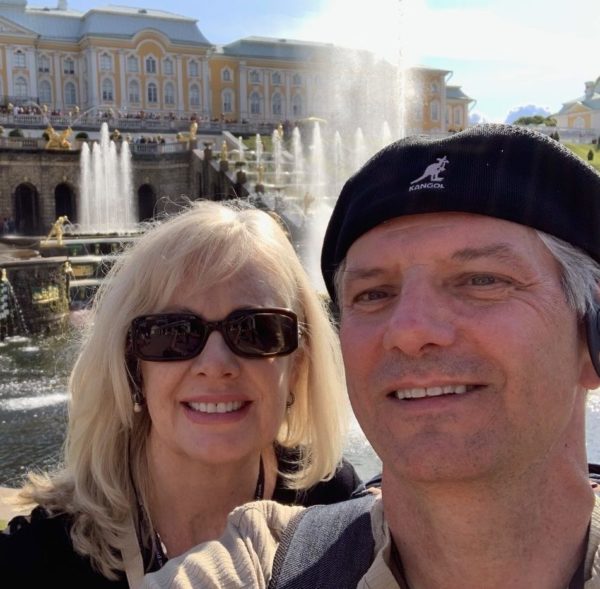
Larry & Audrey Ketchersid
2019 Volga Dream Platinum
Read a Story#1 on Volga Dream Cruise experience and story#2 on Moscow tour experience.
Story #3. Peterhof (Петерго́ф), St. Petersburg, Russia
In July 2019 my wife and I spent an afternoon at Peterhof outside of St. Petersburg. This stop was a part of our Volga Dream cruise tour. We took a hydrofoil across the Gulf of Finland after lunch, toured the gardens and fountains, and were bussed back to our hotel in St. Petersburg. The weather was excellent, making the gardens a bit crowded. One afternoon is certainly not enough to see everything. We did not venture into Peterhof Grand Palace because of the excellent weather outside and a planned trip to visit the Catherine Palace in Pushkin (which, we were told, had similar architecture) the very next day.
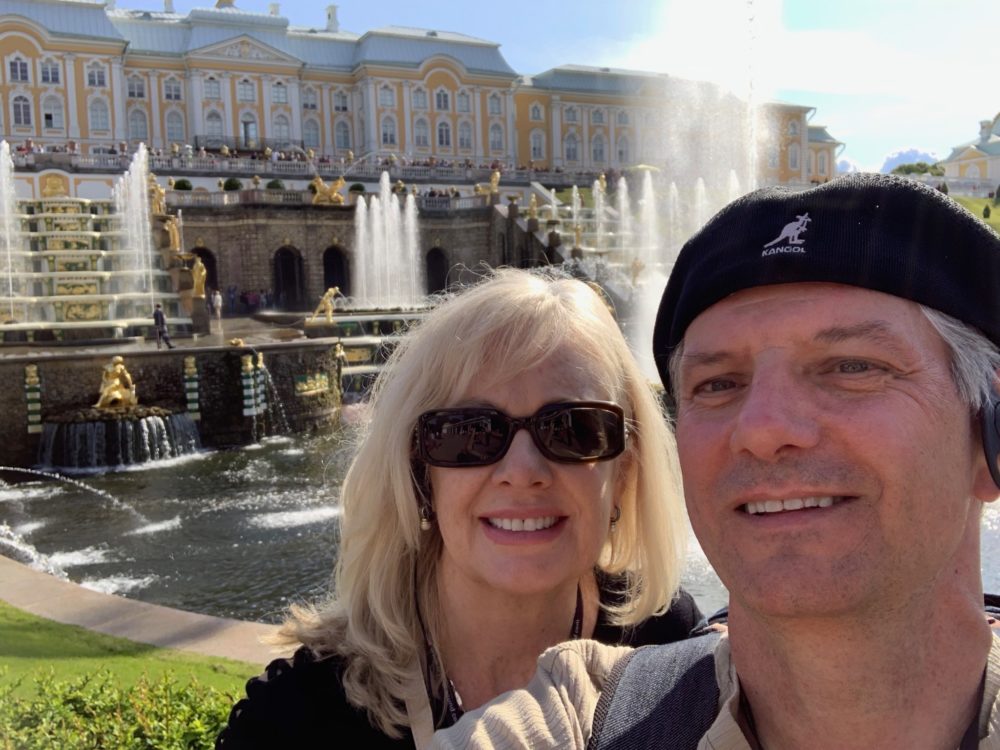
The Grand Cascade (shown in the background of the photo above) and the Samson Fountain were certainly the main event. We ended our stroll of the gardens there so lots of photos (perhaps too many) below. But first….
Hydrofoil to Peterhof
The Hydrofoil ride took between 30 and 45 minutes. The trip leaves from the docks along the Neva River and ends at the docks within sight of the major fountains known as the Grand Cascade.
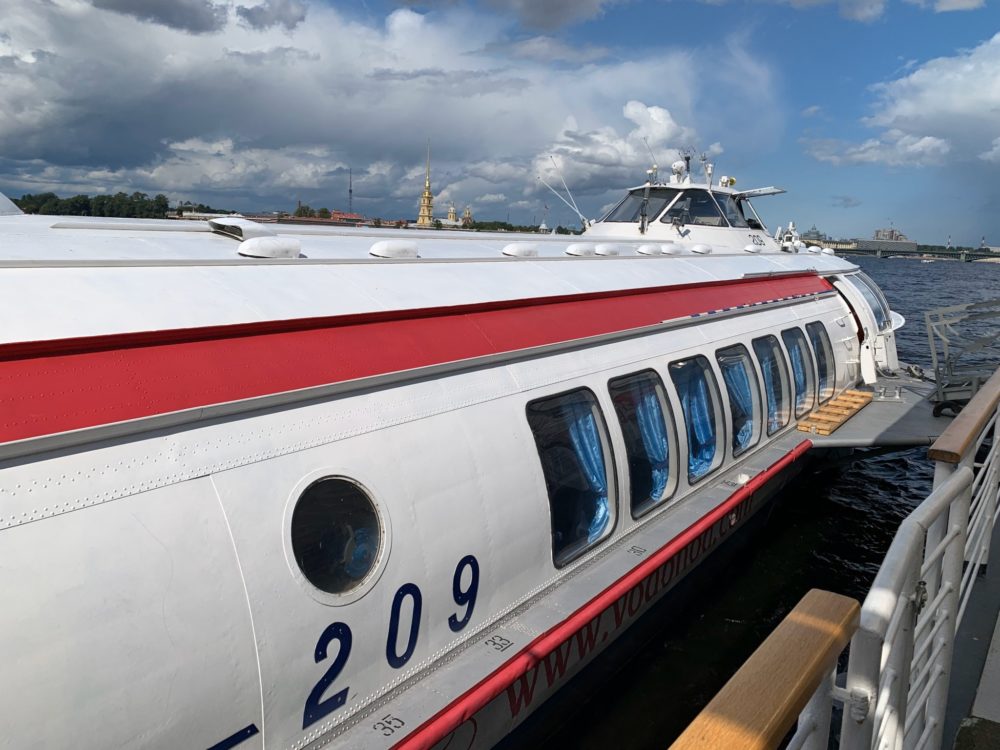
The boat coasted while in close to the city. Once we got under the bridge and out into the bay the captain opened it up.
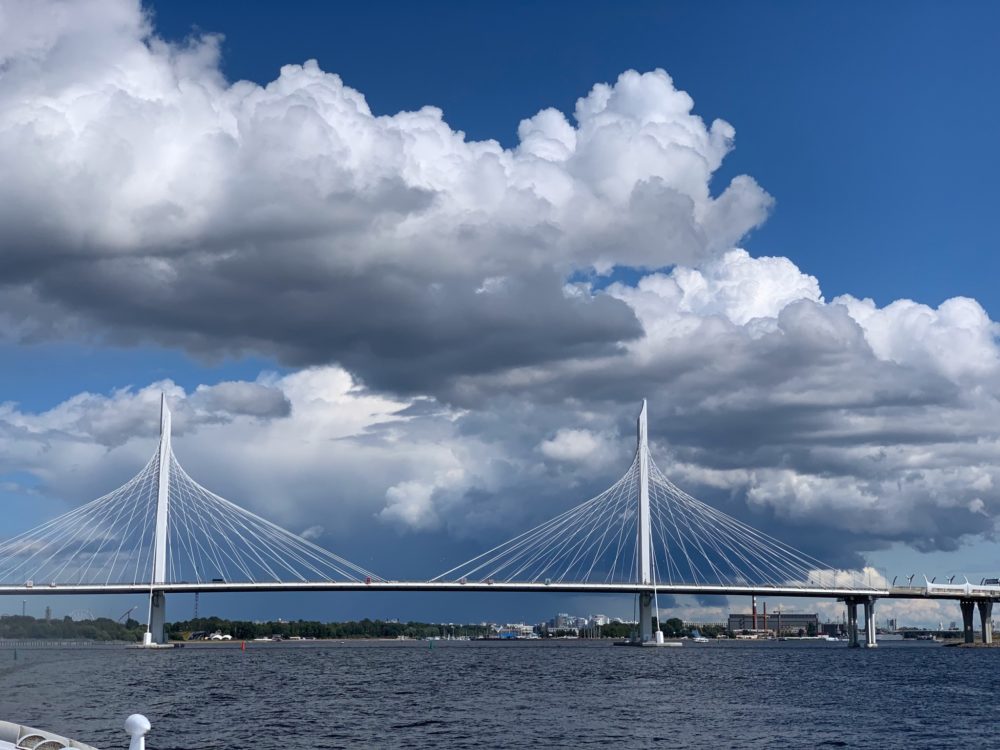
Once out into the bay, the hydrofoil passed lots of buildings, including the local stadium and the Lakhta Center.
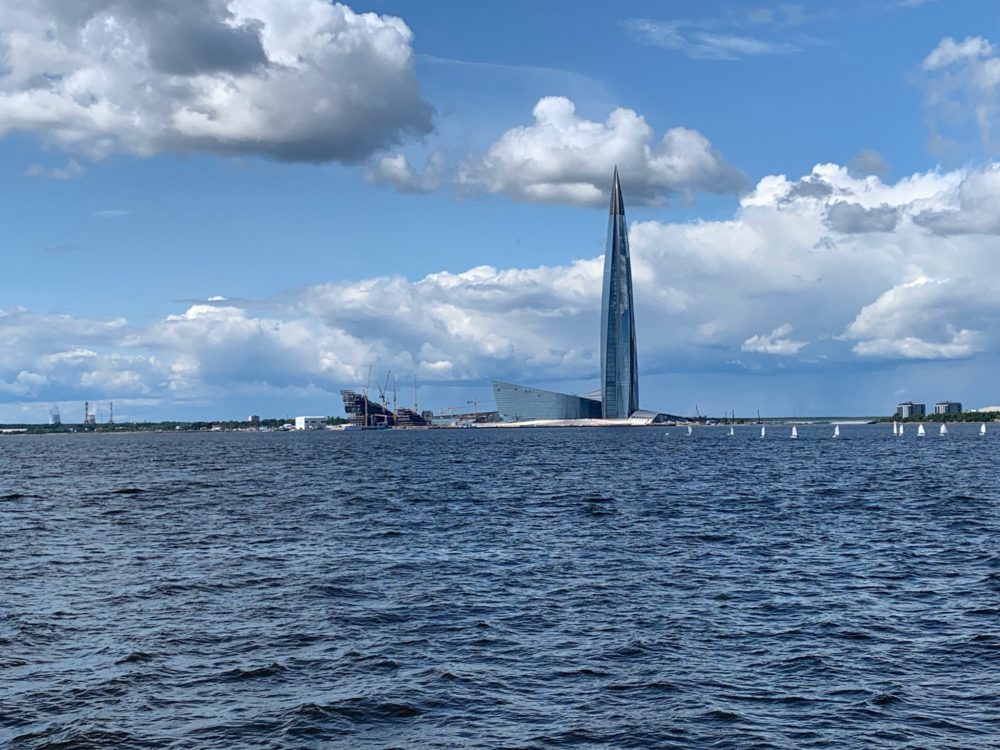
The Lakhta Center is the tallest building in Russia, the tallest building in Europe and the 16th tallest building in the world. When I asked any local about this building (such as our guide) the subject of the building was met with a hint of derision. The Historic Centre of Saint Petersburg and Related Groups of Monuments (which includes Peterhof) was named a UNESCO World Heritage Site in 1990. Some articles that I’ve read said there was a backlash against the tall building because of thoughts that it would impact views of the historic city.
The day was gorgeous and it was a Sunday. There were lots of boats on the water including a regatta of sorts that passed the hydrofoil heading back toward the bridge. The photo below is off the back of the hydrofoil.
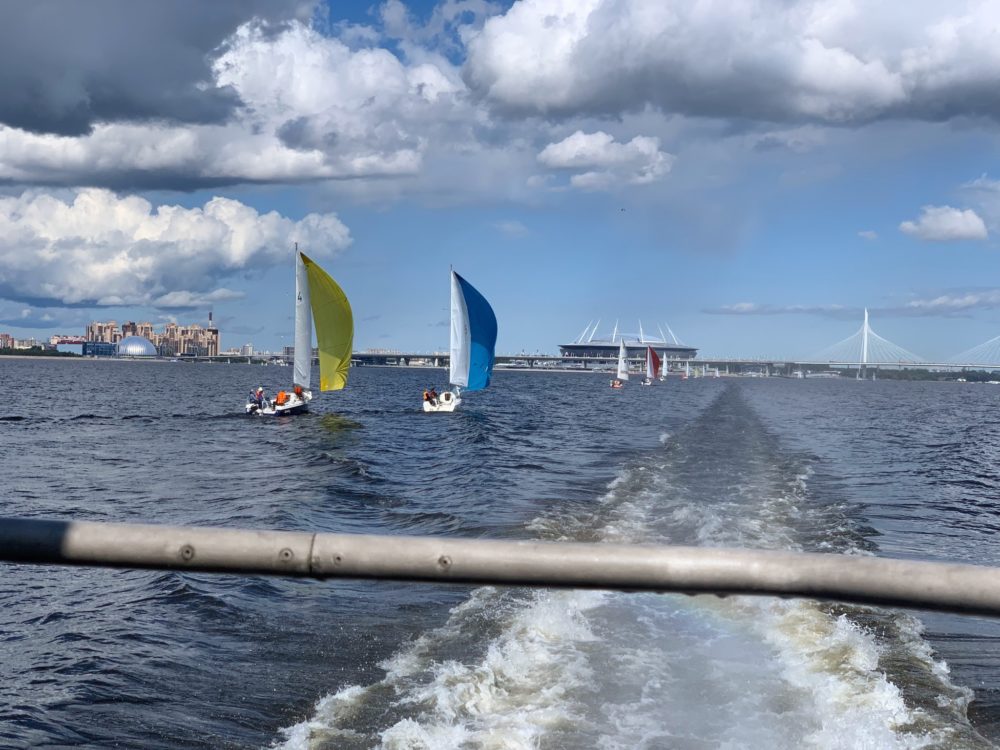
We disembarked the hydrofoil at the dock right at the end of the canal that leads from the Great Cascade to the Gulf. As can be seen in the photo below, lots of people were out enjoying the grounds on a beautiful Sunday afternoon.
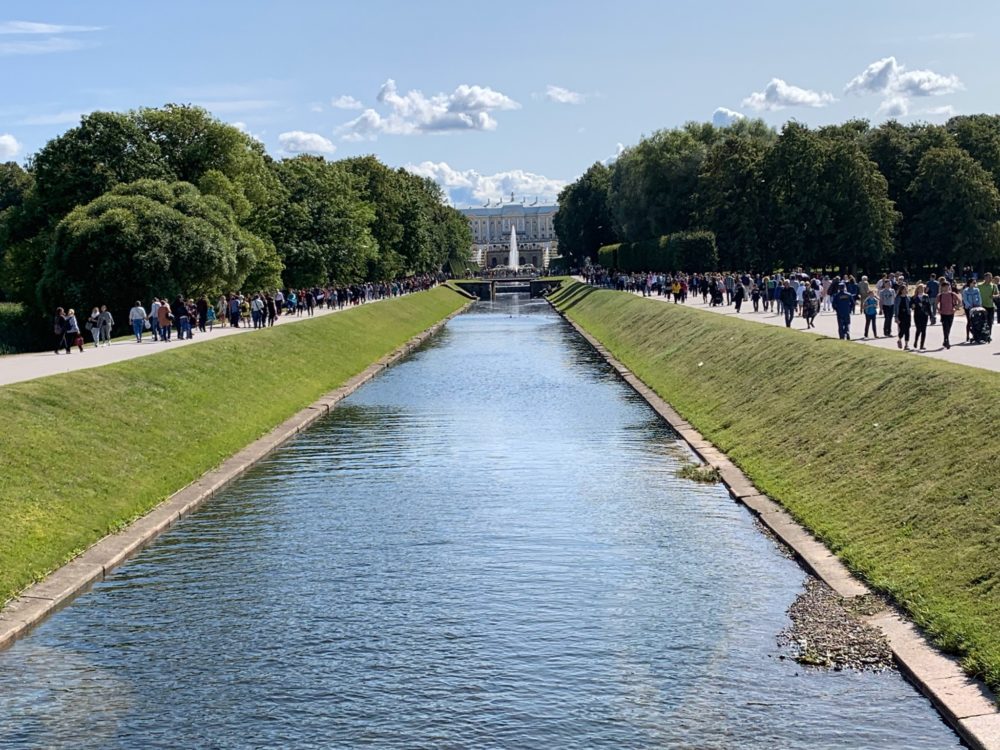
Peterhof Gardens
The Peterhof State Museum Reserve is a massive place; the Lower Garden is 102.5 hectares, which is just over 250 acres. The entire grounds encompass four times that much – over 414 hectares, which is over 1,000 acres. A large garden and museum complex deserves a large map (found here). Below is a small crop of that map.
The Lower Gardens are laid out in a very planned, thoughtful and symmetrical system. At the top of the map is the pier where the hydrofoil docked. The Samsonovsky Channel leads straight to the Grand Cascade, which sits right behind the Palace. On the eastern side is the Chessboard Cascade, whose alley leads right ton Monplaisir Palace. And on the western side is the Golden Hill cascade, which leads to the Marly Palace area.
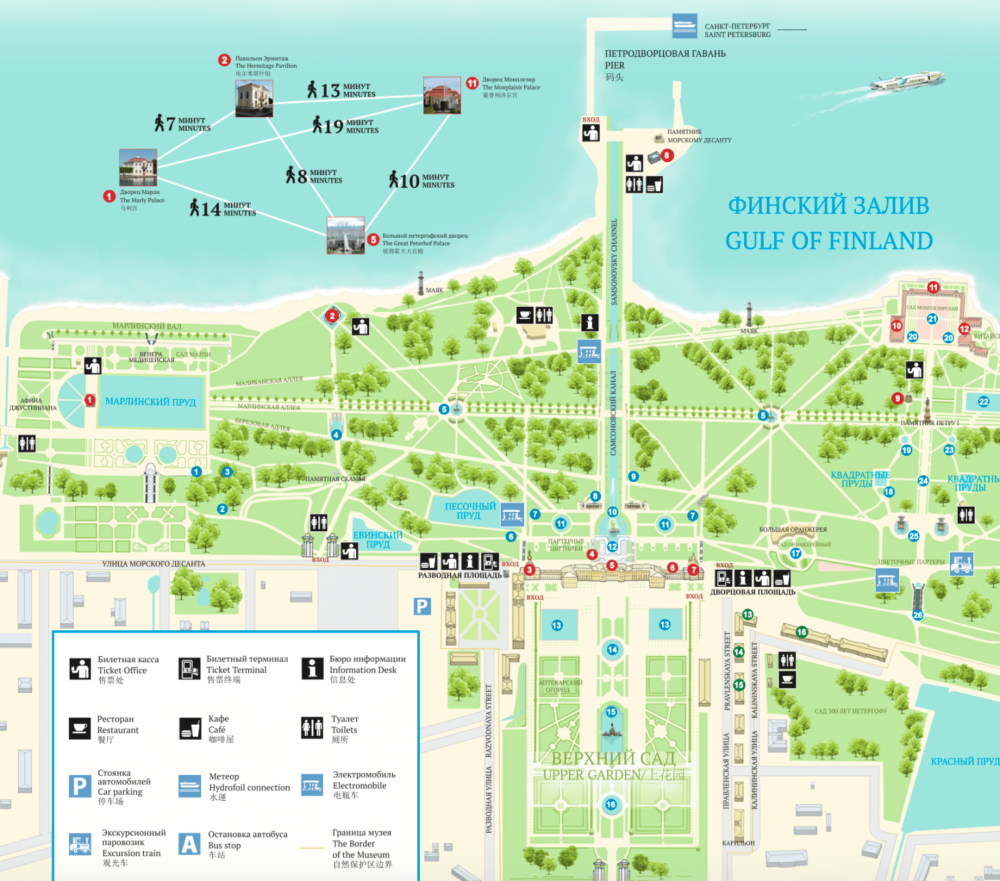
This layout was from ideas and plans of Peter I; each palace and pavilion should have its own matching cascade.
The construction of the main residence started in 1714, with the grand opening on August 15, 1723. From the Peterhof website:
«By that time, all the principal elements of the ensemble composition were formed: the Lower park had been already laid out, the Sea Channel had been excavated and some of the fountains had been in progress. The Upper Chamber as well as the Monplaisir and Marly palaces had been erected.»
The Monplaisir Palace and the Bathhouse Block
Our tour (part of our Volga Dream cruise from Moscow to St. Petersburg) took us toward the eastern side of the gardens and our first stop. Monplaisir Palace was the first structure built here, with construction starting as early as 1714. Its design was apparently based on Peter the Great’s own sketches. Like everything at Peterhof it is surrounded by gardens, fountains and statues.
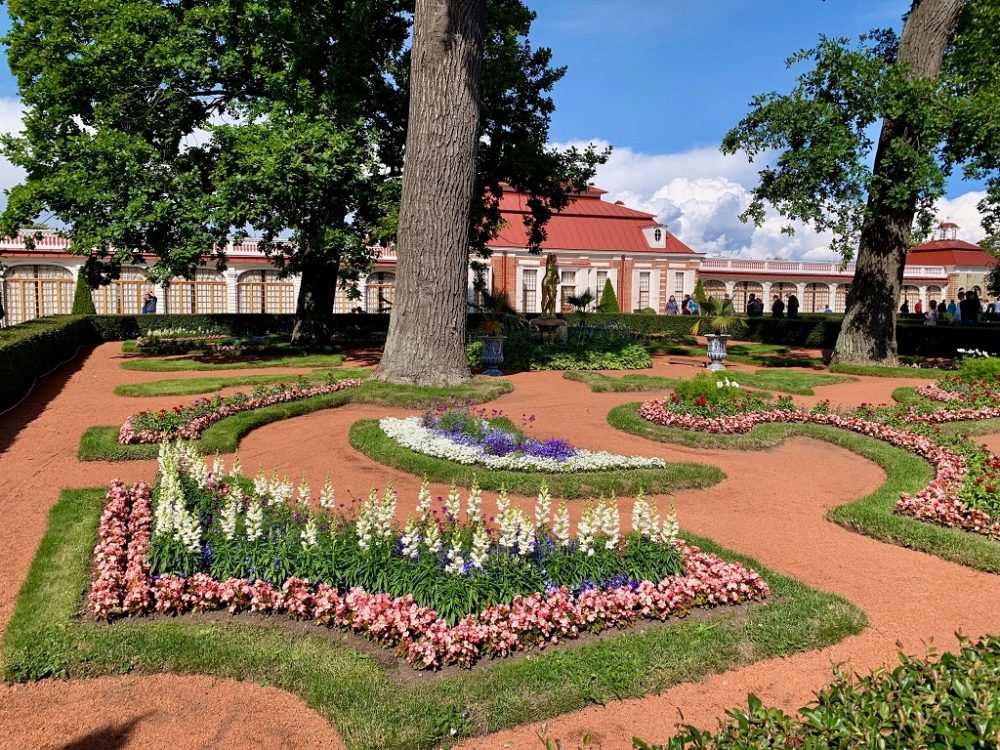
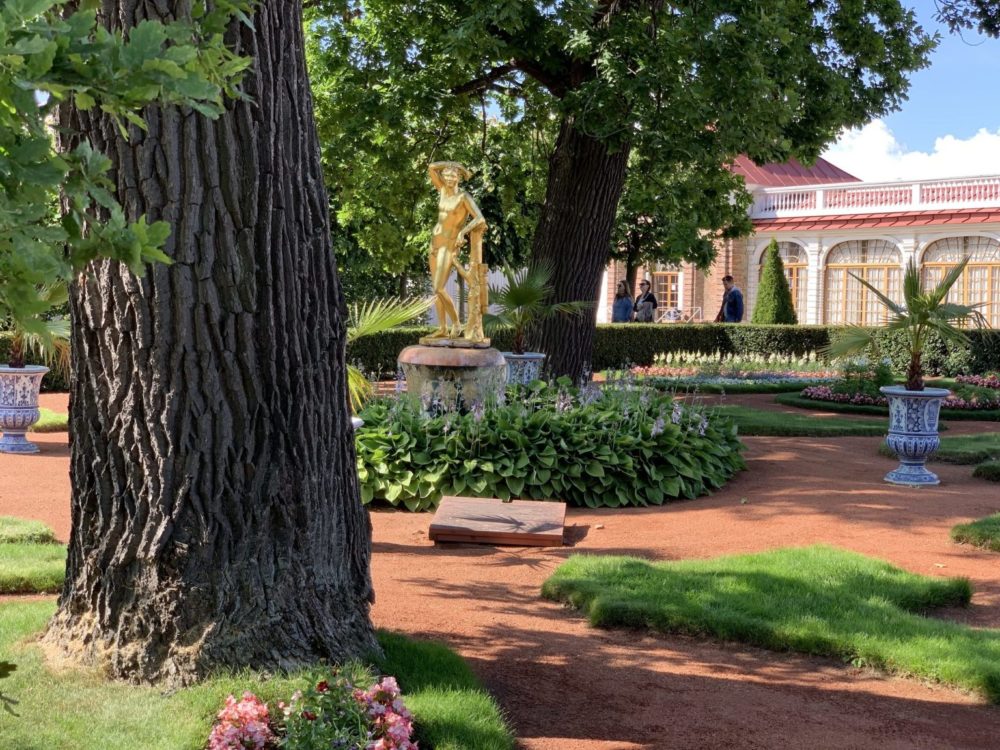
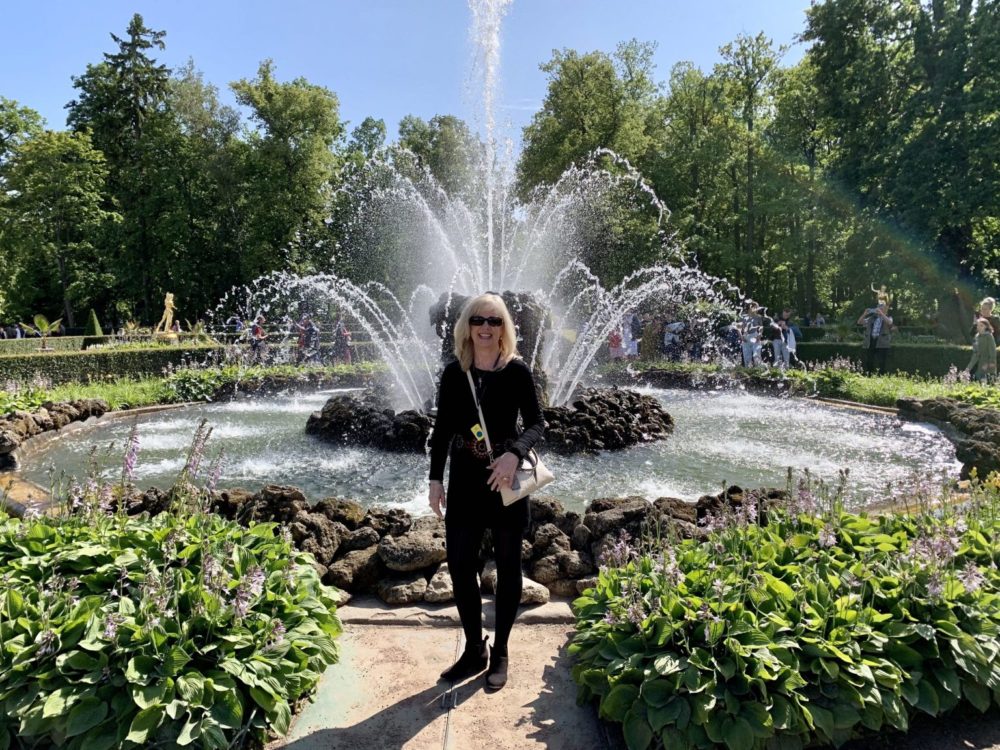
The Monplaisir Palace sits right on the shore of the Gulf of Finland. It was used by Peter as his summer retreat – but he also had a Summer Palace.
We had a brief guided tour inside one of the furnished buildings of Monplaisir. It was decorated, of course, in period furniture.
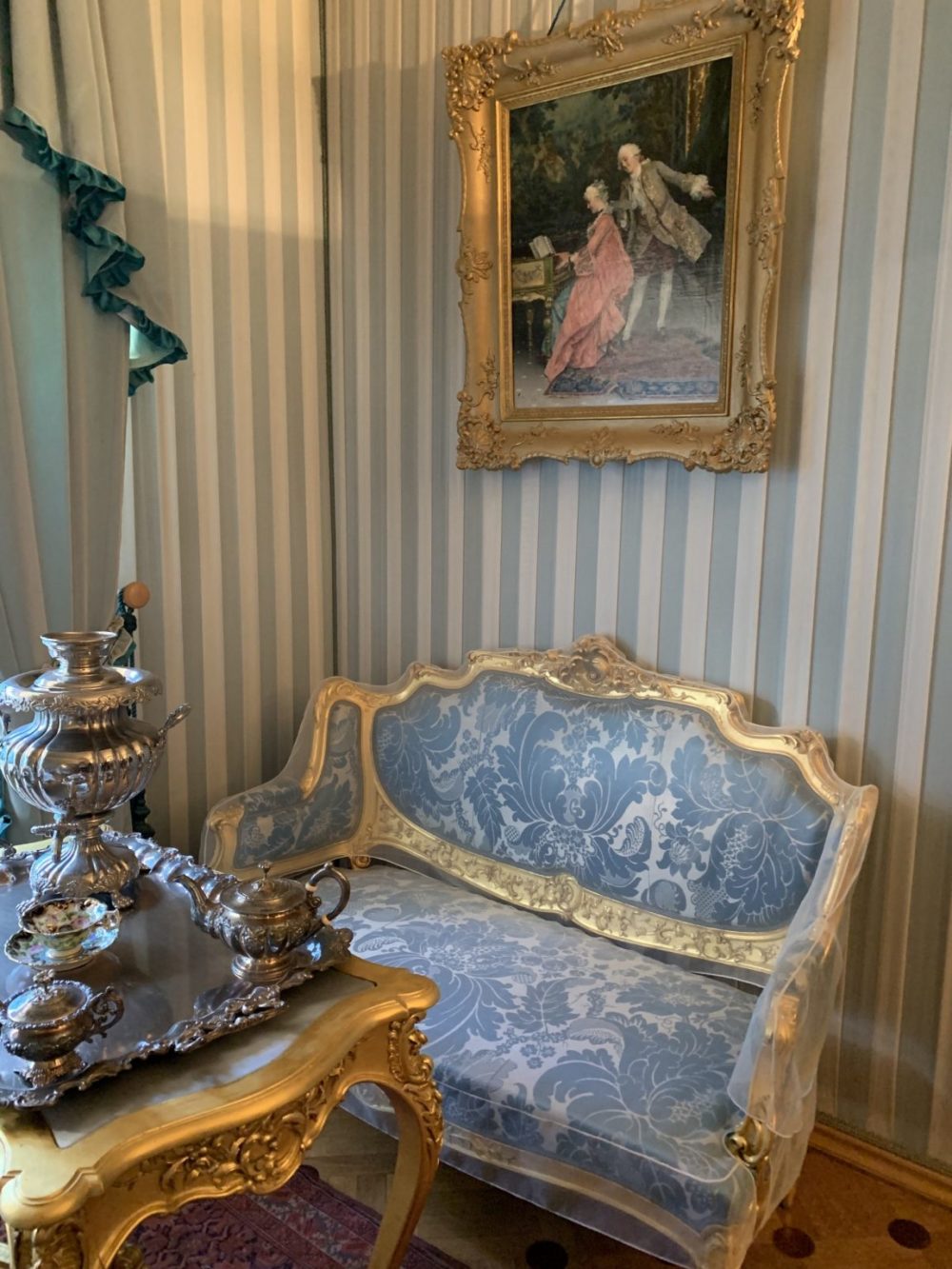
There was a walk-in bath tub with stairs. Bathing (as you’ll see later) was apparently quite the thing.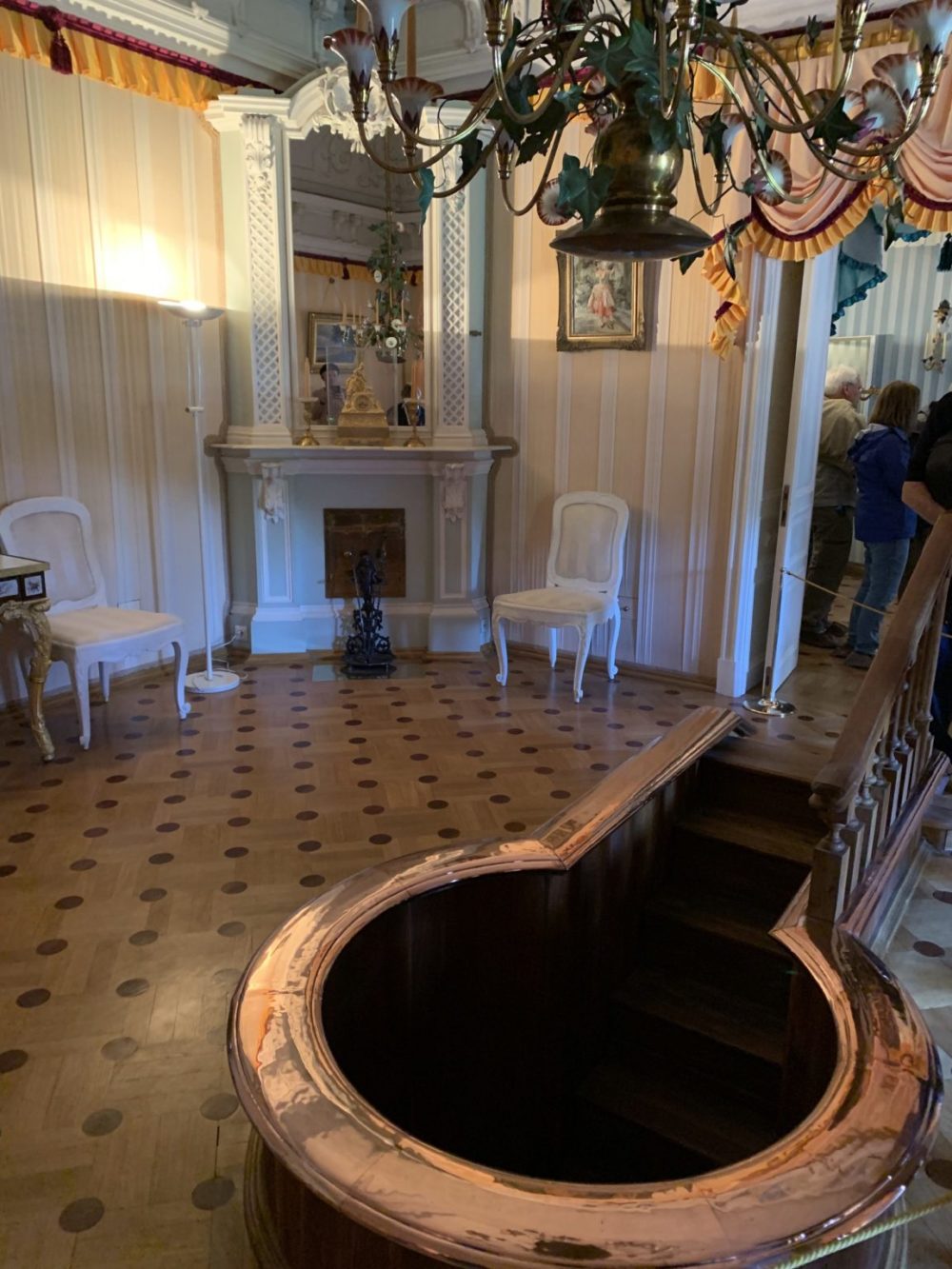
We then walked around back and had a tour of the still-working bathhouse, in a building called the Museum of the Bathhouse Block. This part of the grounds offered a view of the Gulf of Finland.
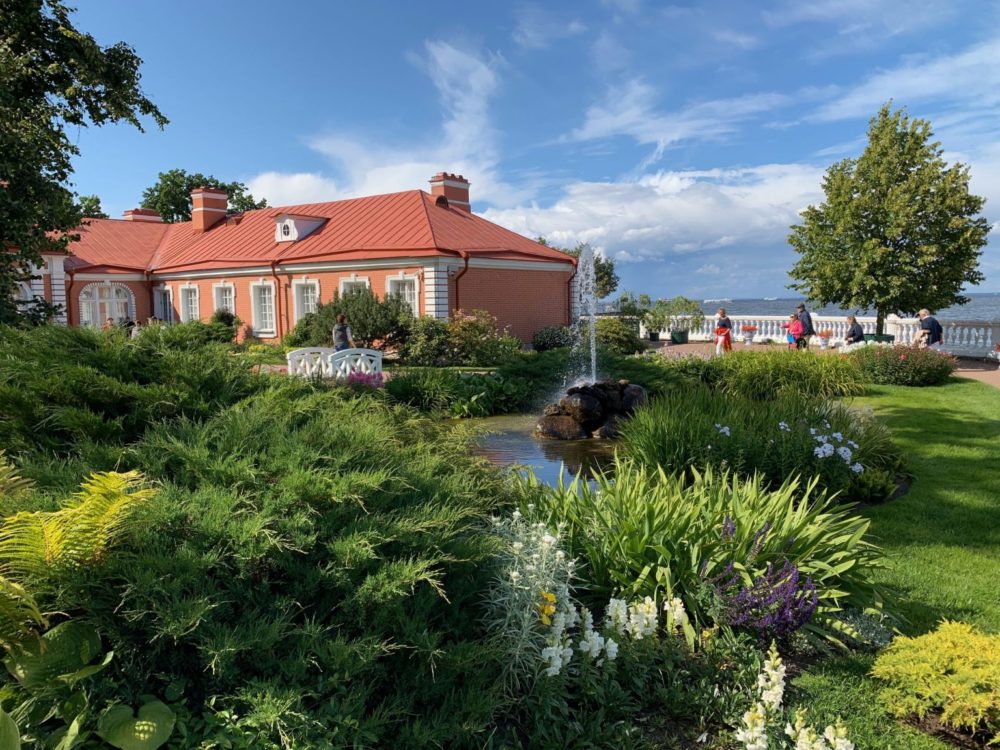
The gardens back here, and everywhere in the park were outstandingly maintained and beautiful.
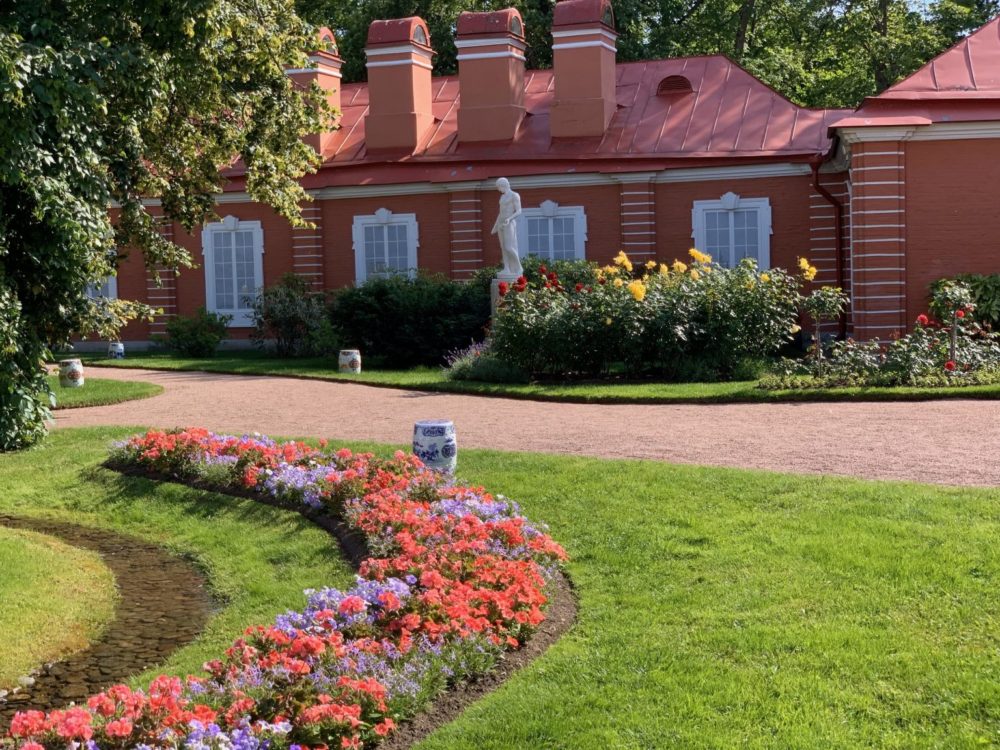
There was a line and a limited number of people that were let into the Bathhouse. Once inside, we saw why. A small group was let inside the old running bathhouse (which is more like a shower), then they turned the pumps on. Video below.
The Aviary
From the Monplaisir Palace we walked up the alley toward the hillside where Peterhof Palace stood. Along that alleyway is the Sun Fountain, and past the fountain is the Aviary.
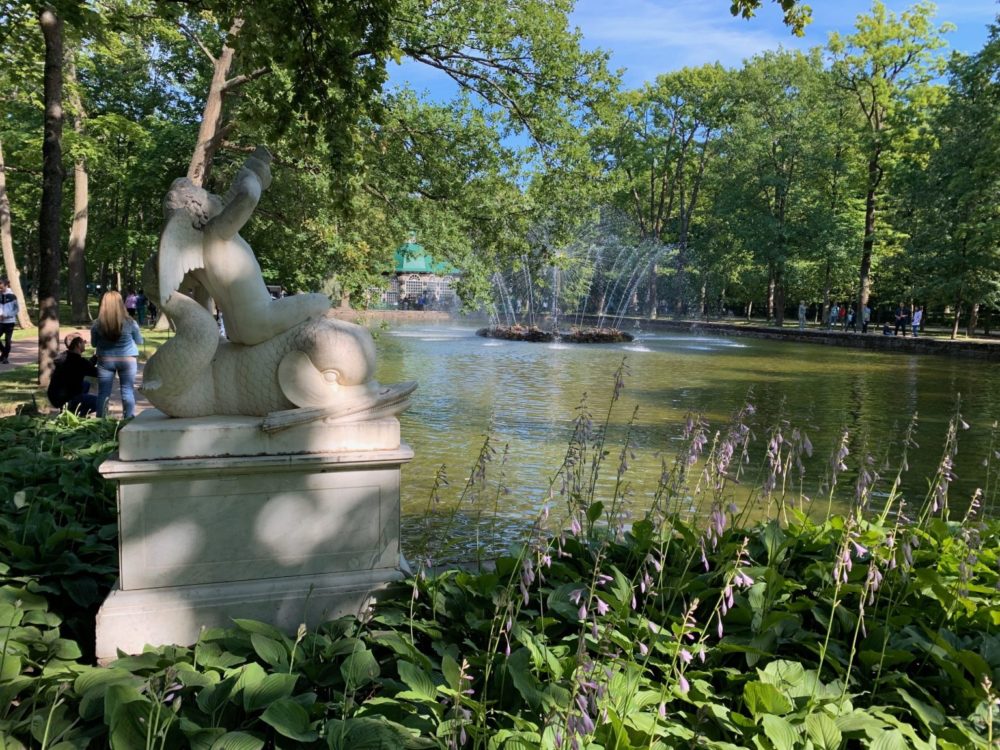
The photo below shows why the fountain is thus named.
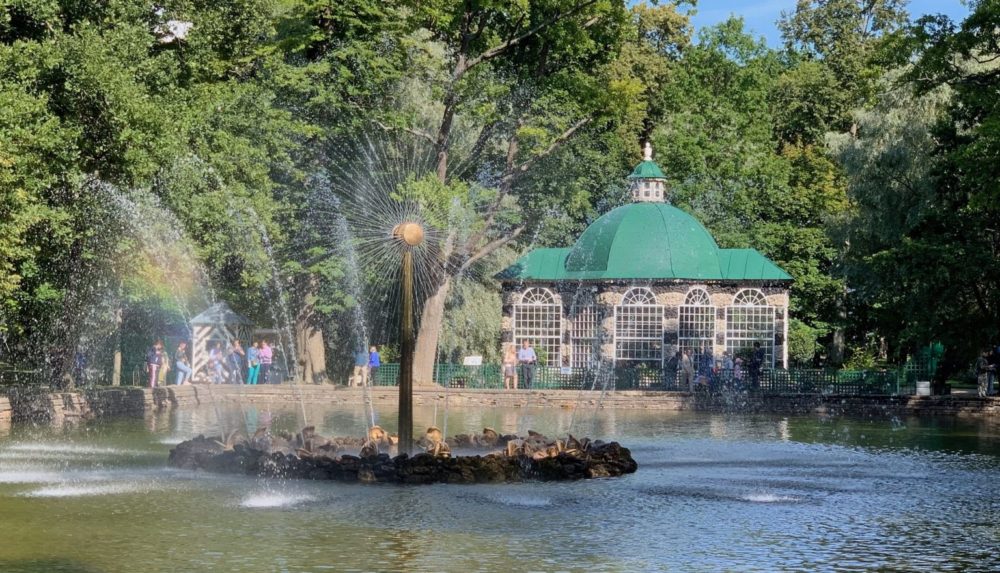
The Aviary has birds in non-winter months.
The Chessboard Hill Cascade
The Chessboard Cascade is one of the three main cascades built into the hillside that separates Peterhof Palace from the Lower Garden.
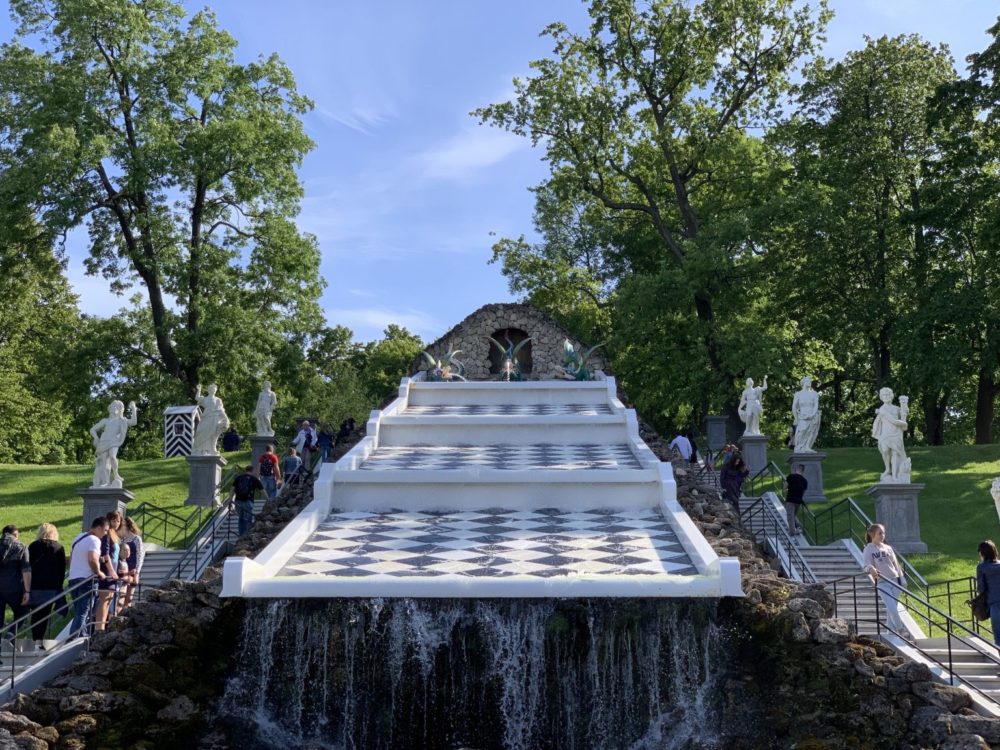
As can be seen in the photo there are dragons at the top of the Cascade and statues along both stairways up to the top. I briefly abandoned our tour group (leaving my gorgeous wife as always to explain my whereabouts) to get a closer look.
The photo below zooms in on the dragons at the top of the cascade.
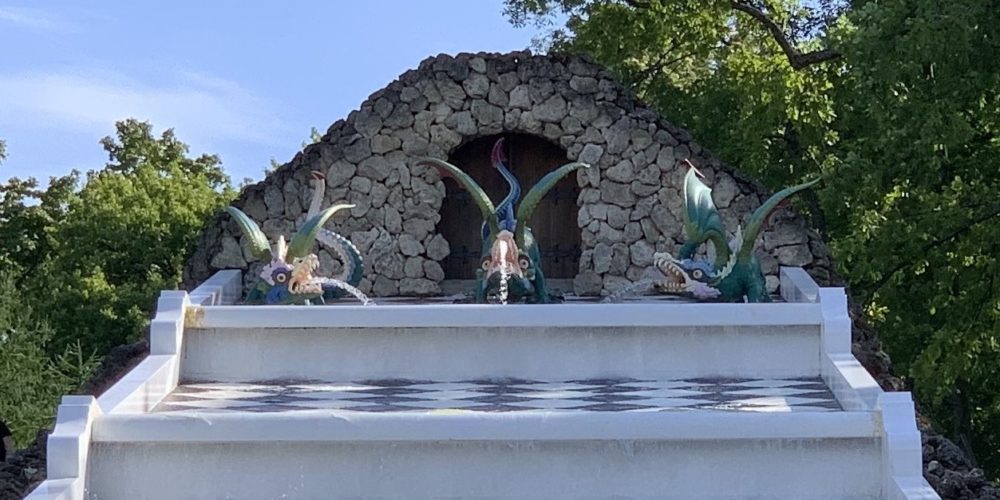
There is a rock wall lining the edge of the cascade, so after I climbed up the stairs I couldn’t get a photo of the entire dragon. But the amazing colors on their wings can be seen in the photo below.
And yes, I briefly climbed a tree to get a better view, though it was still not a full view.
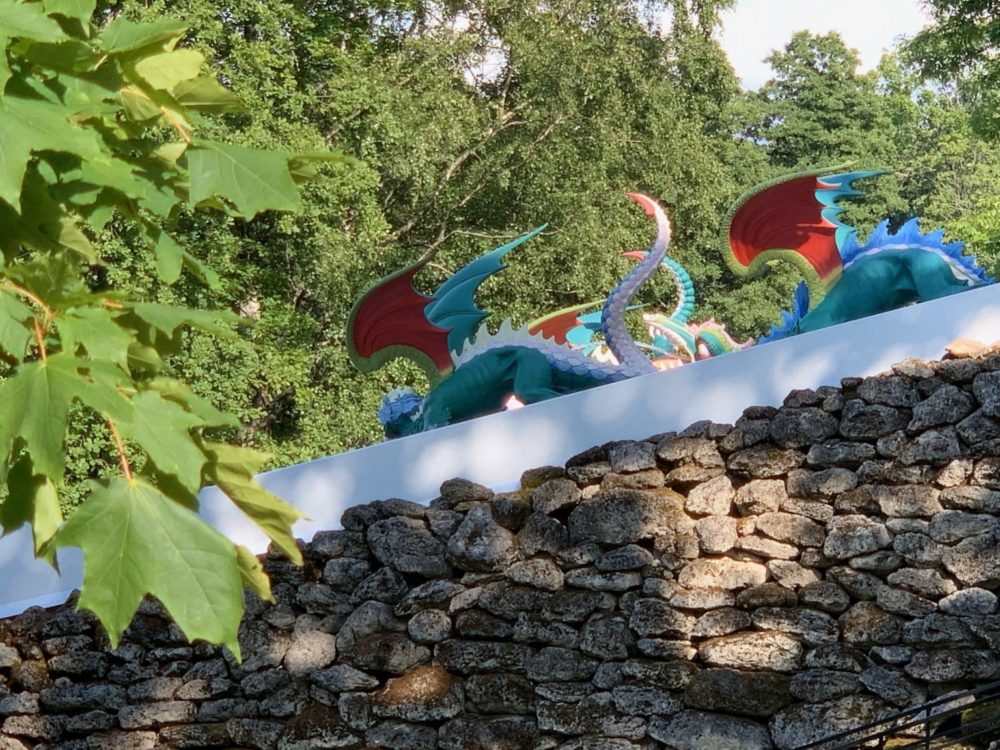
The stairways on both sides was lined with statues. Below is a look back toward the rest of our tour group looking down the way I climbed. If the alley was not overgrown with foliage the Monplaisir Palace could be seen at the end – such is the design of the Lower Garden.
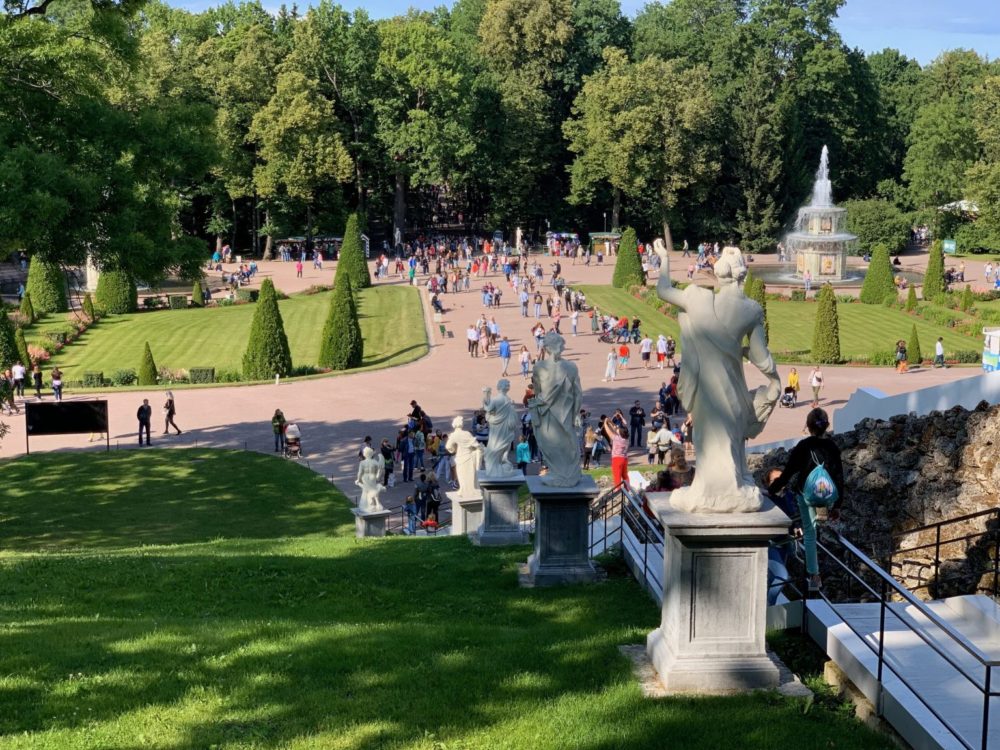
The Fountain of the Orangery Garden
There was a path along the top, so while the rest of our tour group took the lower route, I took the high road! It offered a unique perspective of the gardens below.
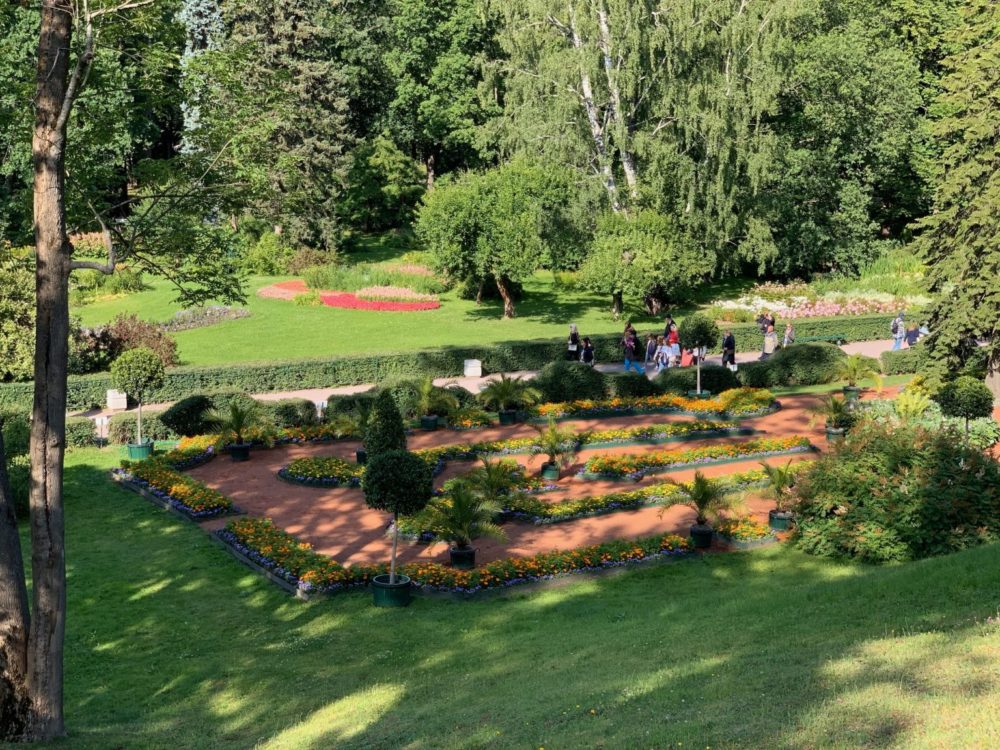
From above the gardens, I got a glimpse of what is called “Museum Court.” From the map of the grounds, it appears that the buildings in the photo below are the Benois Family Museum.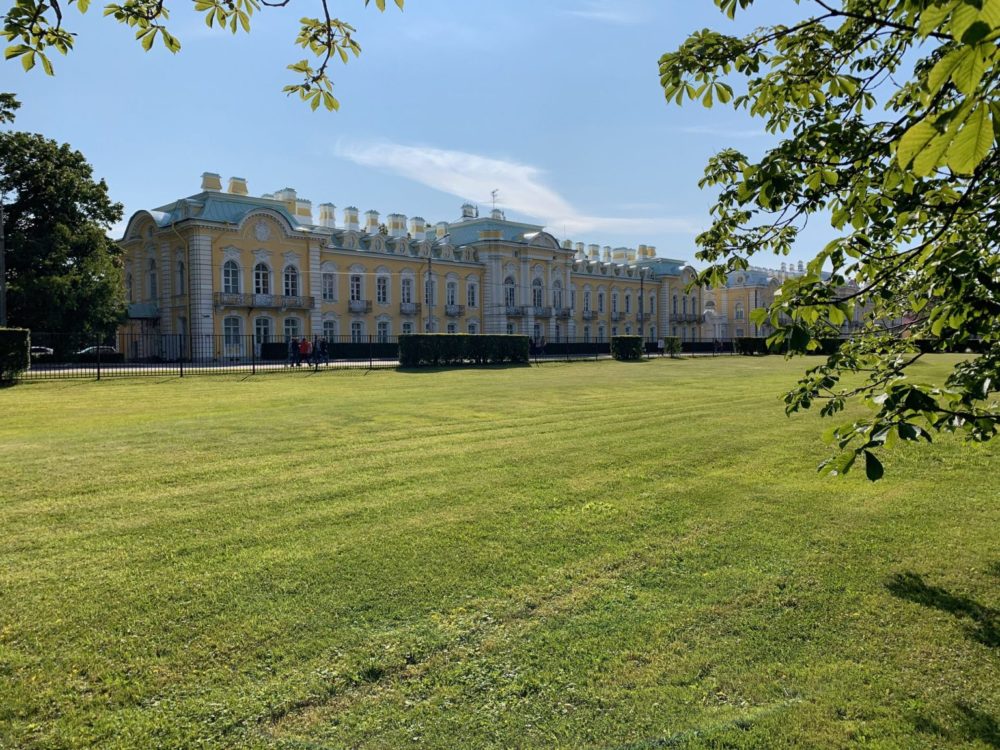
I walked along the upper trail, as the group below approached and the walked through the Orangery, with a beautiful fountain in front of it.
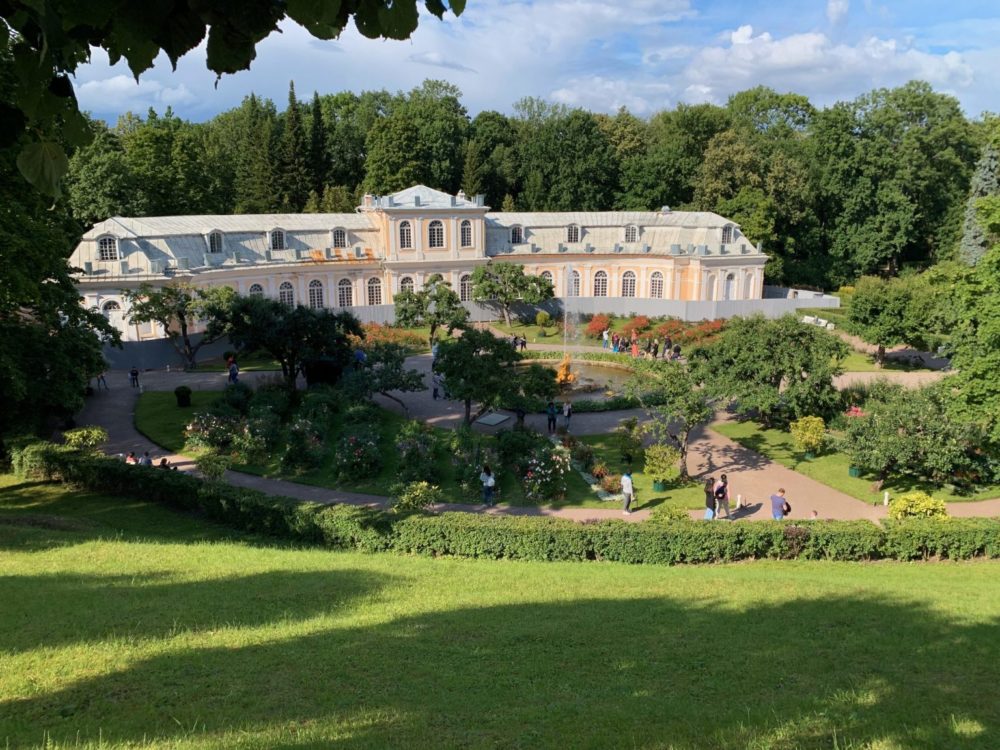
I took the stairs down to rejoin our tour group and get a closer look at the fountain. The fountain, which is named (I believe aptly)“A Triton Tearing Apart the Jaws of a Sea-Monster”. Accordingto the Peterhof web site:
«The fountain…represents an allegory of the triumph of Russia in the struggle for the Baltic Sea. Triton personifies the young Russian navy, that inflicted a decisive defeat to the Swedish squadron at the cape of Gangut, on July 27, 1714. The fleet of Charles XII, is implied as the sea-monster. The four turtles scattering in fear in different directions, are reminiscent of the Swedish king’s infidel allies.»
The fountain was destroyed during the German occupation in World War II and rebuilt from the original plans after the war. The entire palace and area suffered from damage, looting and general desecration while that part of Russia was occupied during World War II.
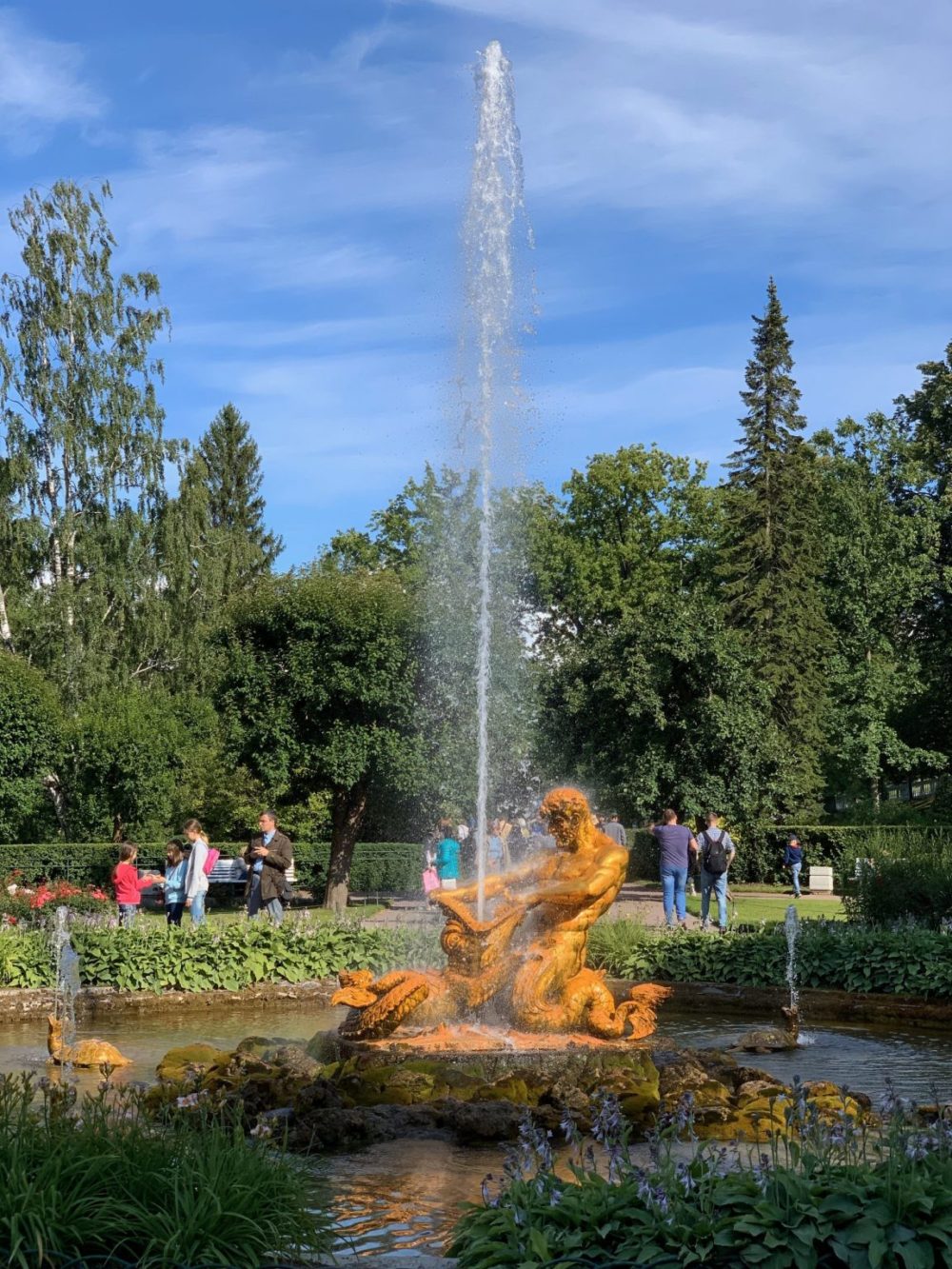
The Great Cascade and Samson Fountain
When we had first arrived at Peterhof, we could see the Great Cascade (the main attraction!) in the distance, with Peterhof Palace looking down. Approaching it from the side, with all of the additional gardens and fountains was just as breathtaking.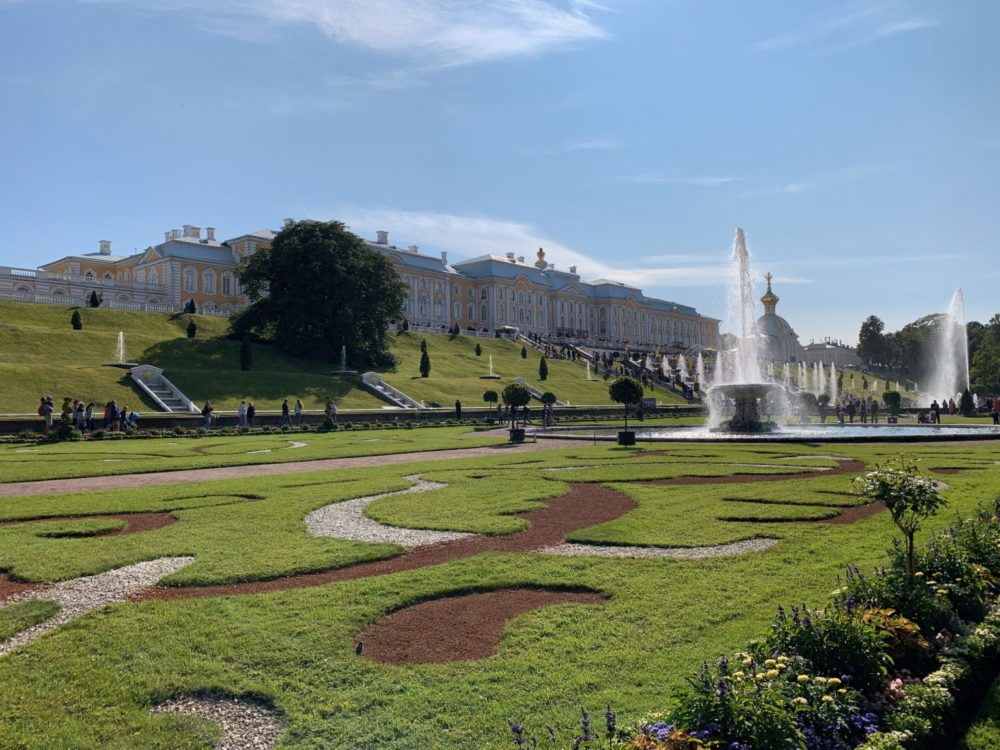
In the photo below, the Samson fountain is the one in the distance. It is the highest fountain in the park.
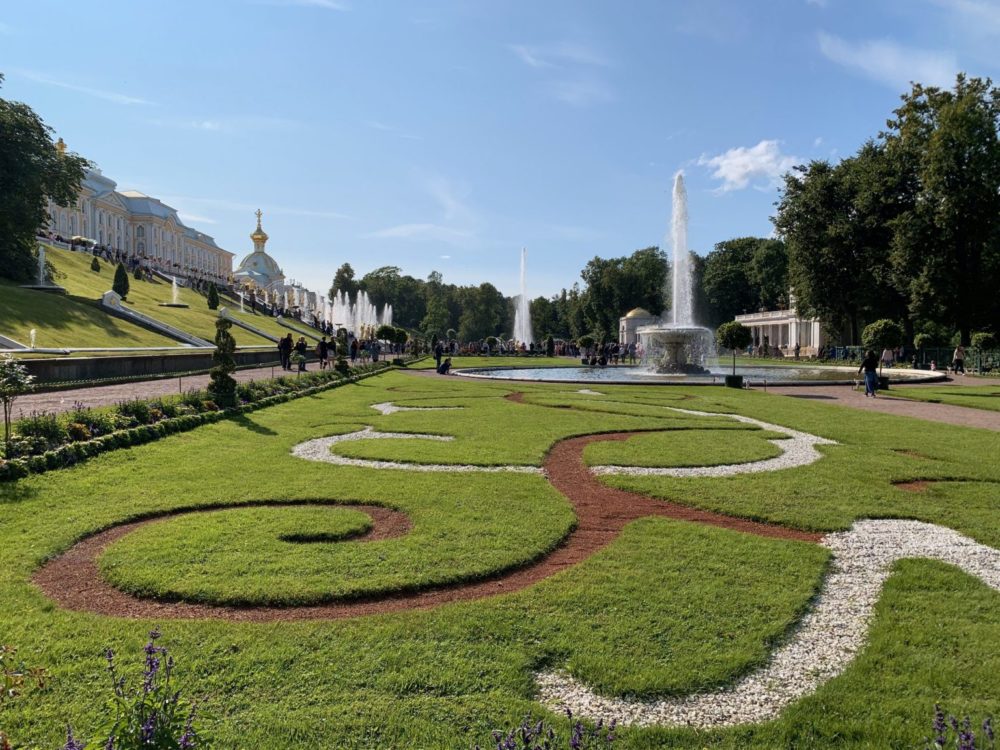
Looking back in the direction where we came we could see the Church Pavilion Museum, which has similar exterior to the Peterhof Palace and surrounding buildings.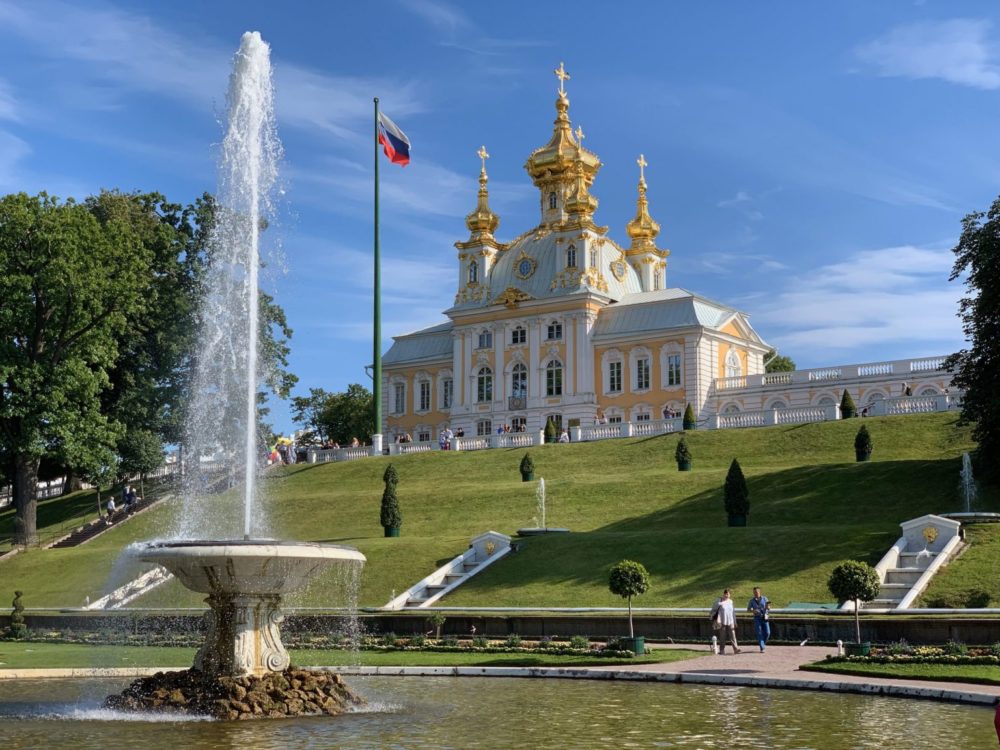
And then, of course, there is the Grand Cascade.
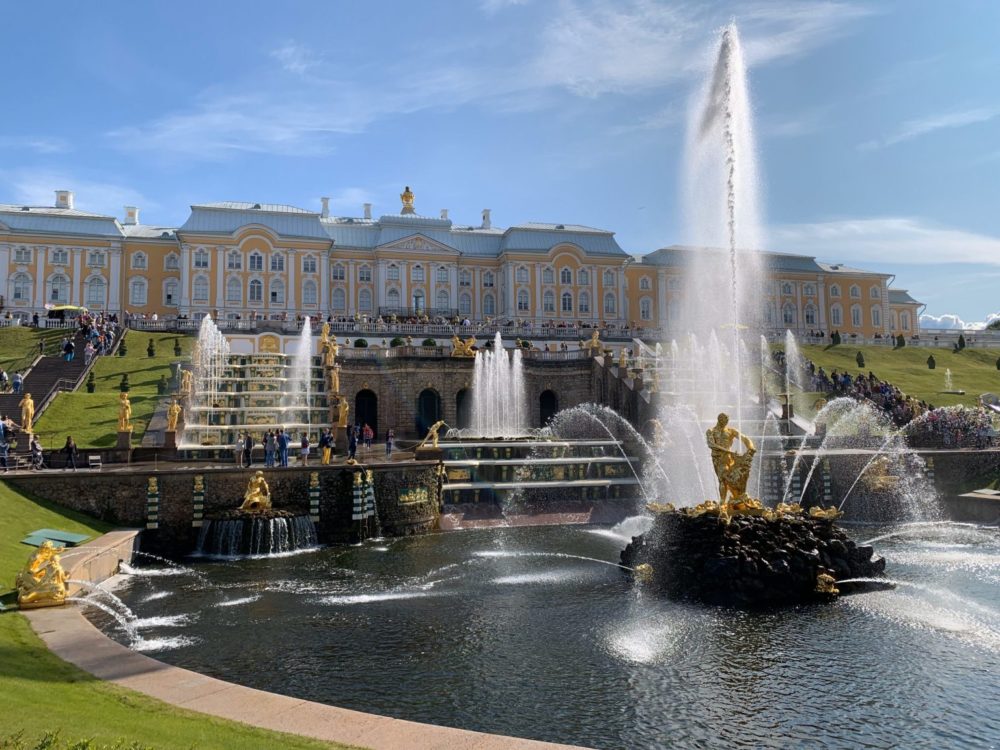
Below is a video of the fountains, and, again, the day couldn’t have featured more perfect weather.
Here’s a close-up of the Samson fountain. The sculptors of this statue and the Triton statue in the Orangery had an obvious dislike for serpents!
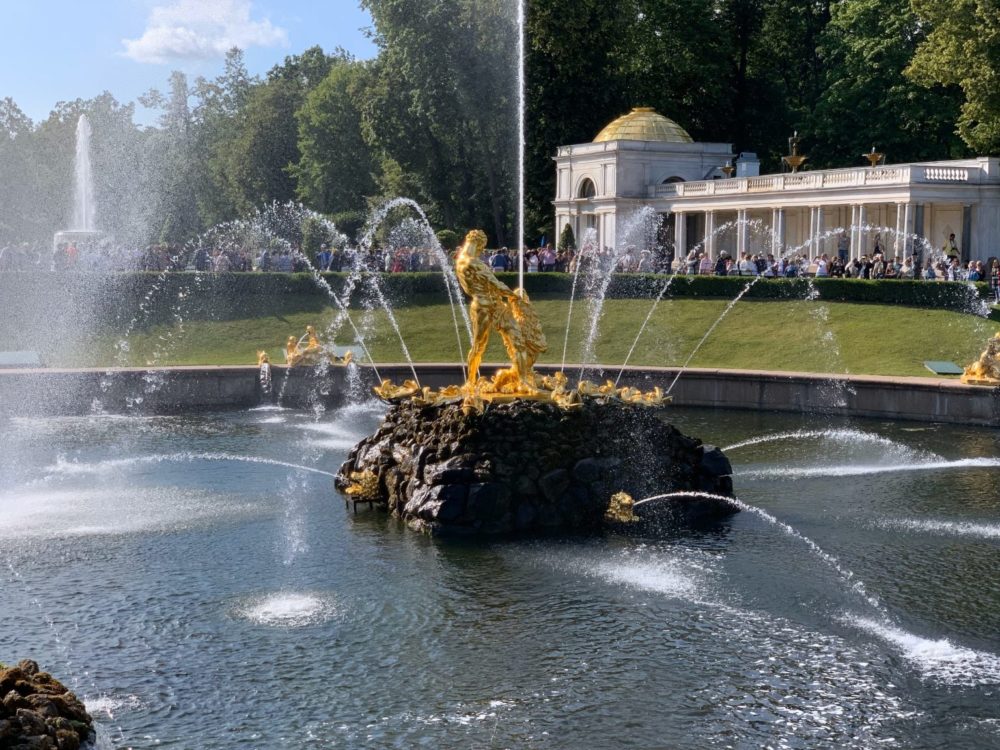
All of the fountains operate without pumps. The water is collected from springs into reservoirs in the Upper Gardens. The elevation from the Upper Gardens and engineering of the aqueduct provides the water pressure for the cascades and fountains. The Samson Fountain, the highest in the park, is supplied with water and pressure via an aqueduct 2.5 miles long.
Below is a video I found (not mind, but I wish it was!) that explains quite well how the Peterhof fountains work.
We climbed up the Grand Cascade to get a closer look at the statues along the stairway.
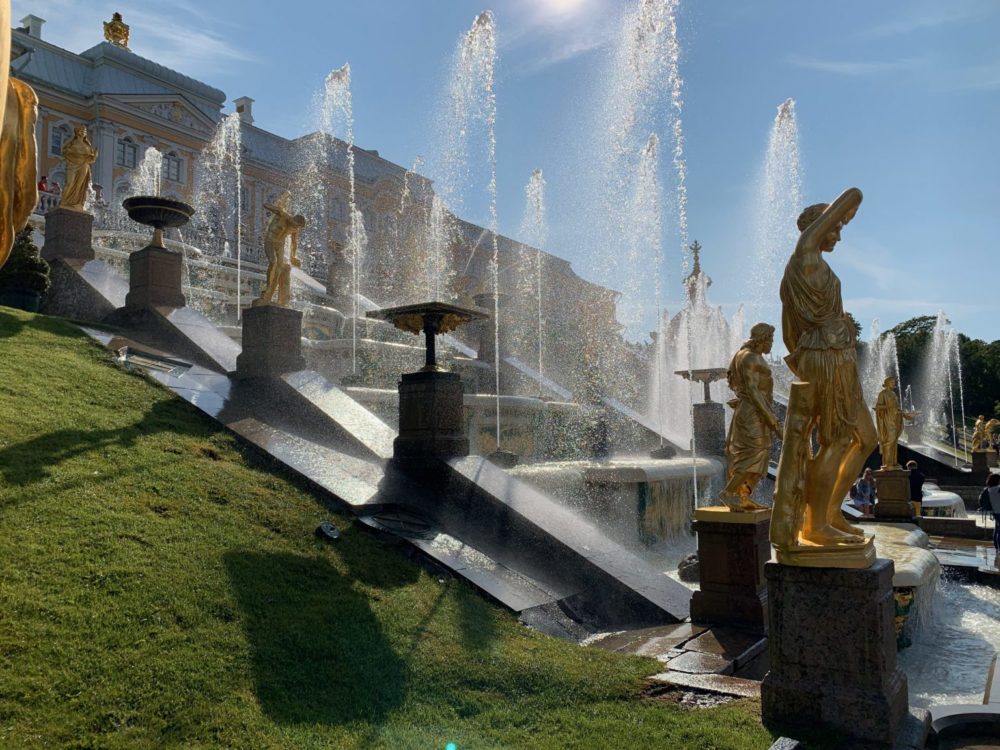
The photo below looks out from Peterhof Palace overlooking the fountains down the sea channel towards the pier.
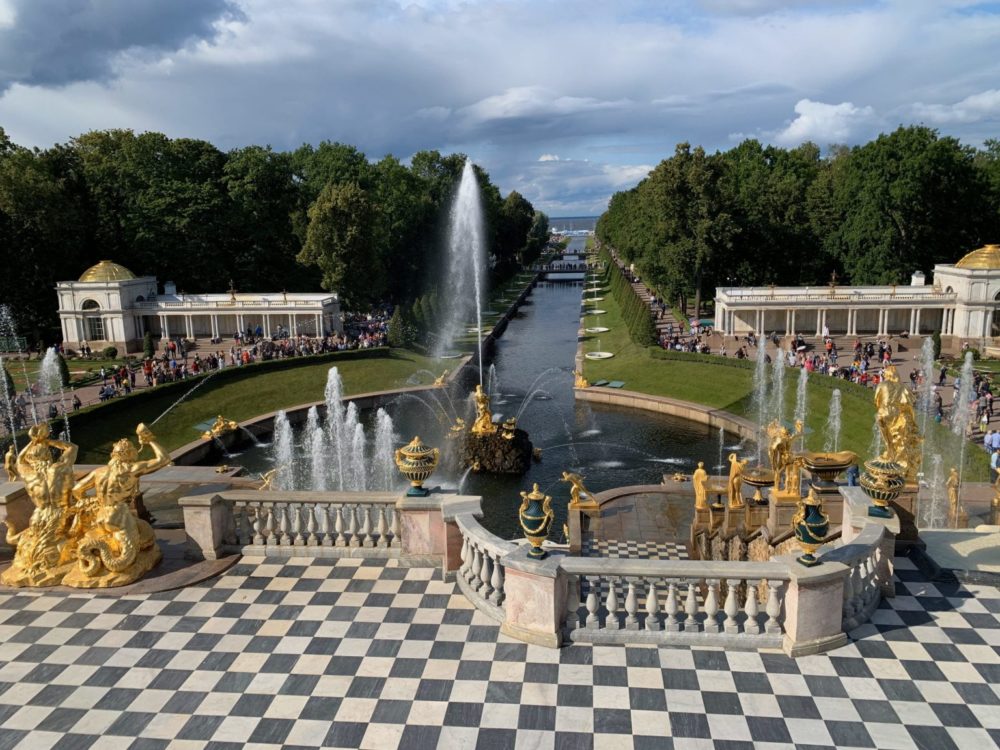
As we left, we took one last look back out over the gardens.
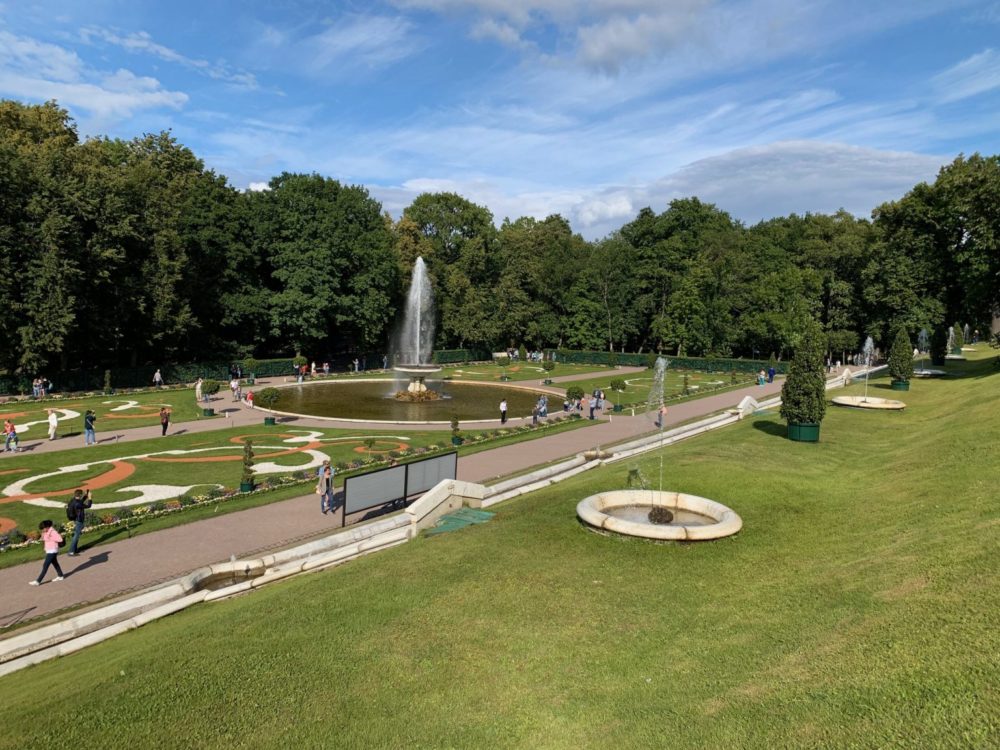
Peterhof deserves more than one afternoon
Peterhof is not the easiest place to visit. We had a 30-45 minute hydrofoil ride out, visited for 2-3 hours and a long bus ride back. We’re not sure why we didn’t take the hydrofoil back, enabling us to spend more time at Peterhof; perhaps the schedules didn’t fit. We briefly considered abandoning the ride back and staying until closing. But the line to get into the Palace itself was so long that people at the end were not going to get in.
There are so many places to see in the world that my wife and I rarely want to retrace our steps, to return to places we’ve already visited. Repeating often doesn’t provide that initial feeling of discovery, the curiosity of seeing everything new.
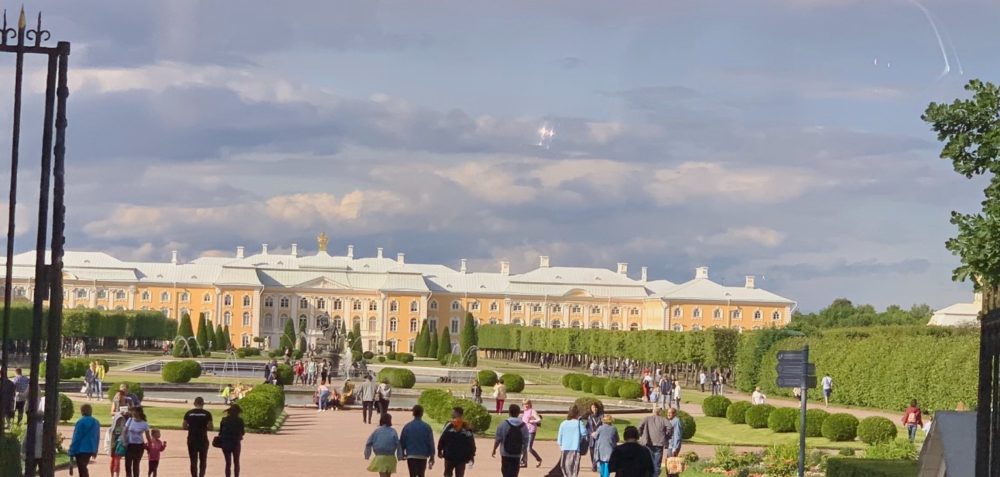
But as we drove past the front of Peterhof Palace, we were already talking about coming back to St. Petersburg, and to Peterhof Palace. I’ve been lucky enough to have visited Versailles several times, and Peterhof is just as large and complex. We hope we’ll be back, and hope we are lucky enough to get the same extraordinary weather.
